
Geranium is a genus of 422 species of annual, biennial, and perennial plants that are commonly known as geraniums or cranesbills. They are found throughout the temperate regions of the world and the mountains of the tropics, but mostly in the eastern part of the Mediterranean region.

Quercus petraea, commonly known as the sessile oak, Cornish oak, Irish Oak or durmast oak, is a species of oak tree native to most of Europe and into Anatolia and Iran. The sessile oak is the national tree of the Republic of Ireland, and an unofficial emblem in Wales and Cornwall.
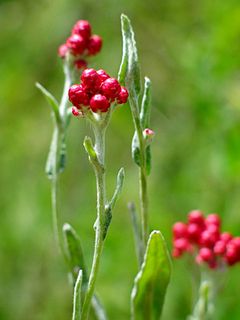
Helichrysum sanguineum (L.) Kostel, known in English as Red Everlasting and Red cudweed is a flowering plant of the genus Helichrysum in the daisy family (Asteraceae). It grows in mountain forests in the Levant where it blooms in April–June.

Fox in Socks is a children's book by Dr. Seuss, first published in 1965. It features two main characters, Fox who speaks almost entirely in densely rhyming tongue-twisters and Knox who has a hard time following up Fox's tongue-twisters until the end.
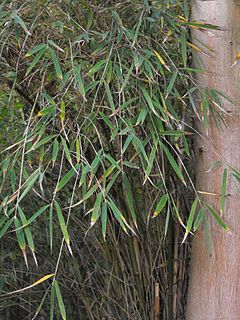
Cephalostachyum is a genus of Asian and Madagascan bamboo in the grass family.

Ribes sanguineum, the flowering currant, redflower currant, red-flowering currant, or red currant is a North American species of flowering plant in the family Grossulariaceae, native to western United States and Canada, but widely cultivated and naturalized throughout temperate Europe and Australasia.

Geranium sanguineum, common names bloody crane's-bill or bloody geranium, is a species of hardy flowering herbaceous perennial plant in the cranesbill family Geraniaceae. It is also the county flower of Northumberland.

Israel, officially known as the State of Israel, is a country in Western Asia, located on the southeastern shore of the Mediterranean Sea and the northern shore of the Red Sea. It has land borders with Lebanon to the north, Syria to the northeast, Jordan on the east, the Palestinian territories of the West Bank and the Gaza Strip to the east and west, respectively, and Egypt to the southwest. Israel's economic and technological center is Tel Aviv, while its seat of government and proclaimed capital is Jerusalem, although international recognition of the state's sovereignty over Jerusalem is limited.

Symphyglossum sanguineum is a species of flowering plant in the family Orchidaceae.
Hygrobia is a genus of aquatic beetles native to Europe, North Africa, China and Australia. It is the only genus in the family Hygrobiidae, also known as the Paelobiidae. These are known commonly as squeak beetles or screech-beetles.
Amoebophyra is a genus of dinoflagellates. Amoebophyra is a syndinian parasite that infects free-living dinoflagellates that are attributed to a single species by using several host-specific parasites. It acts as "biological control agents for red tides and in defining species of Amoebophrya." Researchers have found a correlation between a large amount of host specify and the impact host parasites may have on other organisms. Due to the host specificity found in each strain of Amoebophrya's physical makeup, further studies need to be tested to determine whether the Amoebophrya can act as a control against harmful algal blooms.

Psyche crassiorella is a moth of the Psychidae family. It is found from the coasts of the Mediterranean Sea, through the temperate areas of Europe, to England and north to central Fennoscandia. In the Alps it is found up to heights of 1,200 meters.
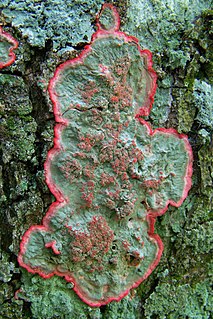
Cryptothecia rubrocincta is a species of lichen in the fungal family Arthoniaceae. The species is distributed in subtropical and tropical locations throughout the southeastern United States, as well as Central and South America, and has been collected infrequently in a few locales in Africa. The body of the lichen forms continuous, circular crust-like patches on dead wood, readily recognizable by the prominent red pigment. The older, central region is covered with red, spherical to cylindrical granules. Moving outwards from the center, zones of color may be distinguished, the first gray-green, the second white, and finally a bright red cottony rim. The red and green colors of this unmistakable woodland lichen give the appearance of a Christmas wreath, suggestive of its common North American name, the Christmas wreath lichen. The red pigment, called chiodectonic acid, is one of several chemicals the lichen produces to help tolerate inhospitable growing conditions.

Homalopoma sanguineum is a species of sea snail, a marine gastropod mollusk in the family Colloniidae.
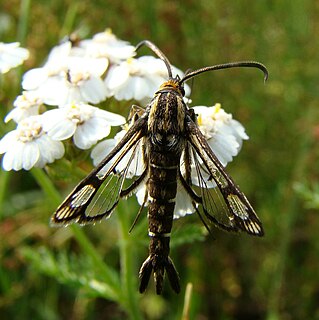
Pyropteron triannuliformis is a moth of the family Sesiidae. It is found from most of Europe to the Near East and Central Asia.

Shell jewelry is jewelry that is primarily made from seashells, the shells of marine mollusks. Shell jewelry is a type of shellcraft. One very common form of shell jewelry is necklaces that are composed of large numbers of beads, where each individual bead is the whole shell of a small sea snail. Numerous other varieties of shell jewelry are made, including bracelets and earrings.

Rhododendron sanguineum (血红杜鹃) is a rhododendron species native to southeast Xizang and northwest Yunnan, China, where it grows at altitudes of 2800–4300 meters. It is a dwarf shrub that typically grows to 0.3–1.5 m in height, with leathery leaves that are obovate, widely elliptic to narrowly oblong in shape, and 3.8–8 × 1.8–3 cm in size. Flowers are red.

Wasing Wood Ponds is a 13.5-hectare (33-acre) biological Site of Special Scientific Interest south of Aldermaston in Berkshire.
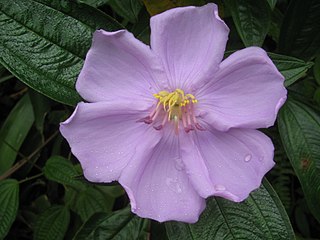
Melastoma sanguineum is called red melastome or fox-tongued melastoma in English. They are erect shrubs or small slender trees with medium-sized violet-pink colored flowers with 6 petals that have made them attractive for cultivation. The leaves have the 5 distinctive longitudinal veins (nerves) typical of plants in the family Melastomataceae.

















